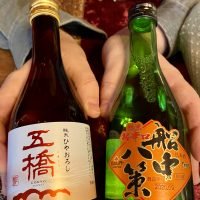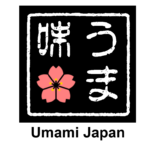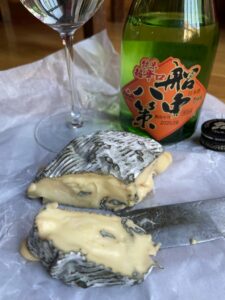
Walter says: Last time we presented a summer sake – even if we were a bit late due to the pandemic. This time we’re pouring two seasonal sake. Some basics: there are three, sometimes four different seasonal sake, and the last one in the year’s cycle, for autumn, is Hiyaoroshi. It undergoes just one quick pasteurisation after the brewing in spring, allowing for an expressive liveliness. At the same time it’s also left to mature until fall, making it more gentle and fuller in taste – both in combination pairs well with autumnal cooking and mood.
Our first candidate comes from Gokyo, a brewery founded in 1871 in the southern part of Japan’s main island Honshu. They are using water from the Nishiki river’s underground section, which is even softer than Japan’s generally quite soft water. That makes the sake very velvety, though it also presents a real challenge to the master brewer. Water altogether is an essential factor because it makes up to 80 percent of sake and is also used for cleaning and steaming the rice.
At Gokyo they use regionally produced rice and try to combine traditional and modern brewing methods. On one hand there is computer-controlled measuring technology, on the other Gokyo is one of the few breweries to reintroduce the challenging fermentation in wooden barrels for some of their sakes. The synergy of high and low tech allows for novel aromas without the need for new yeast or koji strands. This Junmai Hiyaoroshi was matured in tank and pasteurised once, after bottling. The brewery recommends pairing it with grilled mackerel, shiitake and other mushrooms, aubergine with miso sauce, but also fried lotus root.

Brewery: Gokyo
Name: Junmai Hiyaoroshi
Type: Junmai
Alc.: 15 %
SMV: +2
RPR: 60%
Acidity: 1.9
Amino acid: 1.5
Rice: Nihonbanare, Yamada Nishiki
Prefecture: Yamaguchi
Heinzelcheese says: Indeed, all of this is well reflected in the glass. Soft and round and almondy, this sake really caresses tongue and palate! Because Walter told me that autumn sake on principle are served with mushroom dishes, my cheese obsessed mind immediately thought of fungi in form of cheese, our small blue-green-grey friends… Roquefort from southwest France (in this case particularly good stuff from Maison Carles) tastes salty – it has to, to stand a chance as a soft cheese in this kind of format and size – and full of umami, due to ripening and the penicillium roqueforti cultures. It does have another, mellow and yielding side though, because the raw sheep’s milk it is made from is an utter concentrate of fat, protein, lactose and minerals. It is this sweetness that permits the two to latch on to each other. The cheese feels in good hands, the sake loves the salt, and together they seem wonderfully weightless, like a autumn leaf in the wind…
Walter says: Our second autumn sake’s label might look familiar; in October we introduced you to this Senchu Hassaku from Tsukasa Botan in its “normal”, that is twice pasteurised version. Now we have it as a Hiyaoroshi, with the label in autumn colours. Obviously this isn’t a fashion show, but it is really striking how the seasonal element in Japan is reflected not only in cooking, but also in design, art or the presentation of food and drink.
Brewery: Tsukasa Botan
Name: Senchu Hassaku – Hiyaoroshi
Type: Junmai
Alc.: 17,00 bis17,9%
SMV: +8
RPR: 60%
Acidity: 1.7
Amino acid: 1.0
Rice: Akebono, Yamada Nishiki, Tosaurara
Prefecture: Koch
But even more interesting is learning a bit more about the brewing methods. This Hiyaoroshi ferments very slowly at low temperature and afterwards matures at minus five degrees Celsius. That makes it taste very dry, crisp and precise. It pairs well… yes, you got it, strong-flavoured bonito sashimi and of course mushroom dishes – but also Italian dishes involving tomatoes!
Heinzelcheese says: Fresh autumn air rising from the glass! Complex and deep, with the alcohol carrying the acidity and the acidity carrying the alcohol in the finish, as if both were pushed by the autumnal wind. So here too: blue cheese. But a very different one. Made from cow’s milk, soft and creamy, small, less salty, with fungi in and outside. Equally made from raw milk, by Edwin Berchtold from Schwarzenberg in Bregenzerwald/Austria. Sleak and crisp in the glass and an almost decadent richness on the cheese board? Yes, and it is an encounter at eye level, full of mutual respect. The cheese’s lushness puts its friendly, understanding arm around the sake’s acidity (after all any cheese contains lactic acid, even if not always obvious) and makes it even more refined – an improbable, very elegant couple.




